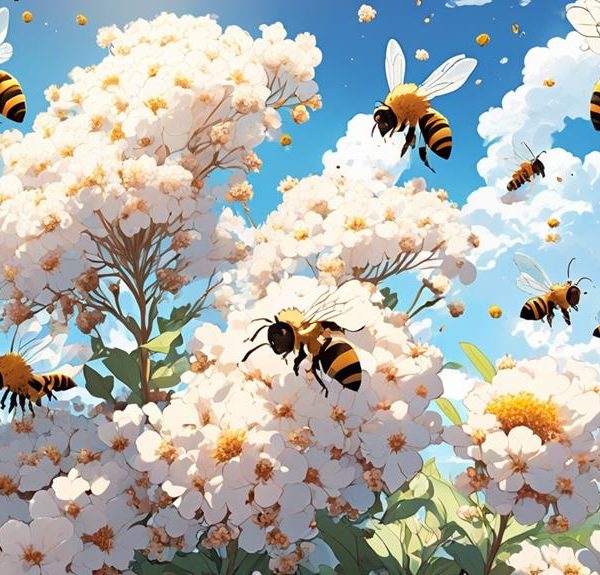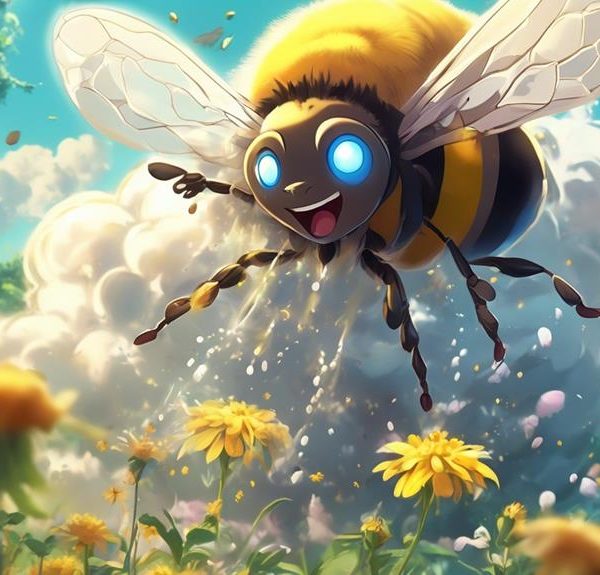Witness the intriguing world of bees and their relationship with the vibrant buddleia plant – a bond veiled in nature's captivating complexity.
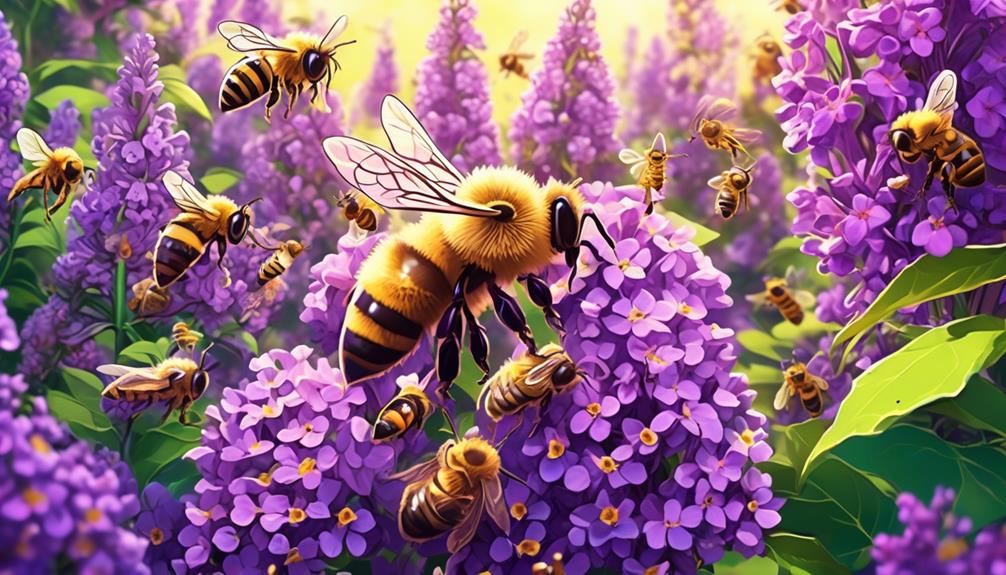
Do Bees Like Buddleia
Like a detective piecing together clues, you're on a quest to discover if bees have a penchant for the vibrant buddleia plant.
You've likely noticed this plant, also known as the Butterfly Bush, teeming with the fluttering insects, but what about bees? Are they equally captivated by its allure?
Observations might suggest so, but as you know, the world of nature often holds deeper complexities than surface impressions reveal.
Armed with curiosity and a thirst for knowledge, let's embark on this journey to unveil the true relationship between bees and buddleia.
Key Takeaways
- Bees are attracted to buddleia due to its rich nectar and pollen content.
- Buddleia's vibrant colors, especially purples and blues, attract bees.
- The fragrance of buddleia flowers adds another layer of attraction for bees.
- Planting buddleia in gardens can help bolster the bee population and contribute to biodiversity and ecosystem health.
Understanding Bee Attraction Factors
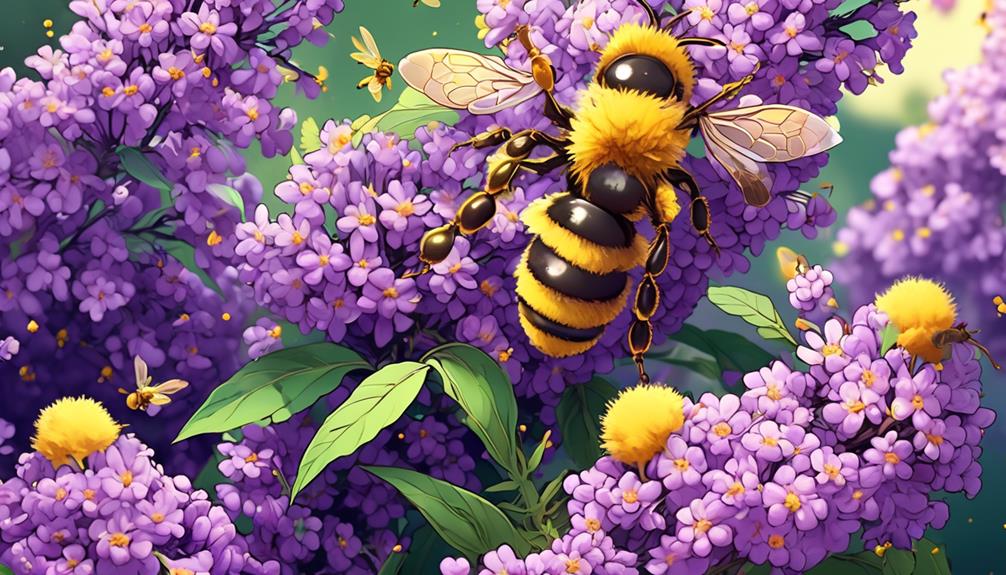
To fully grasp why bees are drawn to Buddleia, it's essential to delve into the key factors that attract these pollinators. You see, bees aren't random in their flower choices. They're driven by a survival instinct that revolves around two main factors: nectar and pollen.
Nectar is a sugar-rich liquid produced by plants. It's the primary energy source for bees and they're incredibly efficient at detecting it. Buddleia, or the butterfly bush as it's commonly known, is a nectar powerhouse. Its tiny tubular flowers are packed with this sweet, energy-rich substance, making it highly attractive to bees.
Pollen, on the other hand, is packed with proteins and fats, vital nutrients for the bee's diet. Again, Buddleia comes up as a winner. The structure and the abundance of its flowers allow for significant pollen production.
But there's more to it. Bees also rely on visual cues. The bright colors of Buddleia, especially purples and blues, are highly visible to bees, and its fragrance adds another layer of attraction.
In essence, bees are drawn to Buddleia due to its rich nectar and pollen content, vibrant colors, and inviting scent.
The Buddleia Plant: A Brief Overview
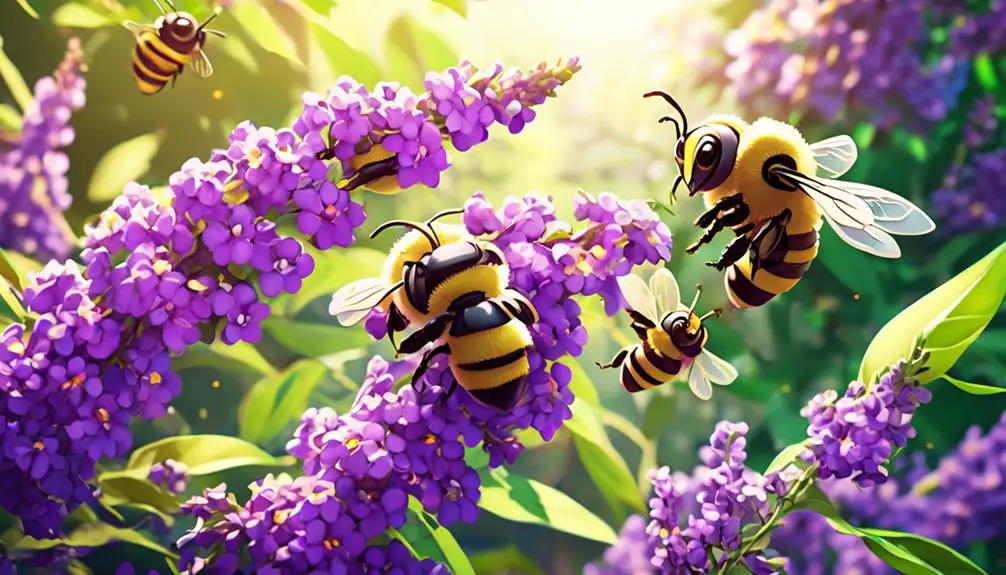
Buddleia, commonly referred to as the butterfly bush, is a plant of immense interest, particularly due to its significant role in the ecosystem. You'll find it originating in East Asia and America, with over 100 species varying in size and color. It's a robust plant that thrives in harsh conditions, often sprouting in wastelands and railway tracks.
Scientifically, Buddleia belongs to the Scrophulariaceae family. It's a deciduous shrub, which means it sheds leaves annually. The plant typically grows up to 5 meters, showcasing elongated clusters of blossoms that range from white to purple.
The nectar-rich flowers are the main attraction, blooming from summer to autumn. They're packed with an array of nutrients, providing a valuable food source for a variety of insects. The plant's fragrance is another drawing card for these insects, luring them from afar.
However, don't be fooled by its beauty. Buddleia's aggressive growth can lead to ecological problems, outcompeting native plants for resources. It's classified as an invasive species in many regions.
Observing Bees in Buddleia Gardens
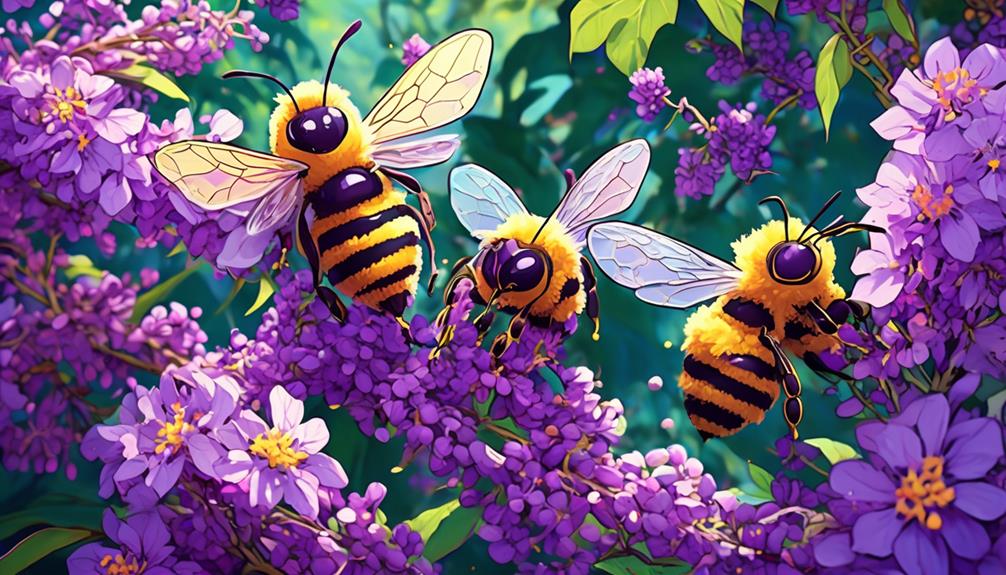
Often, you'll observe a bustling activity of bees in buddleia gardens, attracted by the plant's nutrient-rich nectar and inviting fragrance. As an observer, you might wonder, "What's the connection between bees and this plant?" Well, let's delve into it.
Buddleia, also known as the butterfly bush, provides nectar, a rich source of energy for bees. It's not just the nectar; bees are also drawn to the vibrant colors of the flowers, which serve as visual cues.
Here is a table that outlines some key observations:
Observation | Explanation | Outcome |
|---|---|---|
Bees buzzing around buddleia | Attracted by nectar and color | Increased plant pollination |
Bees landing on buddleia flowers | Collecting nectar | Energy for bees, cross-pollination for plants |
Abundant bees in buddleia gardens | Plant's prolonged blooming season | Sustainable food source for bees |
Scientific Research on Bees and Buddleia
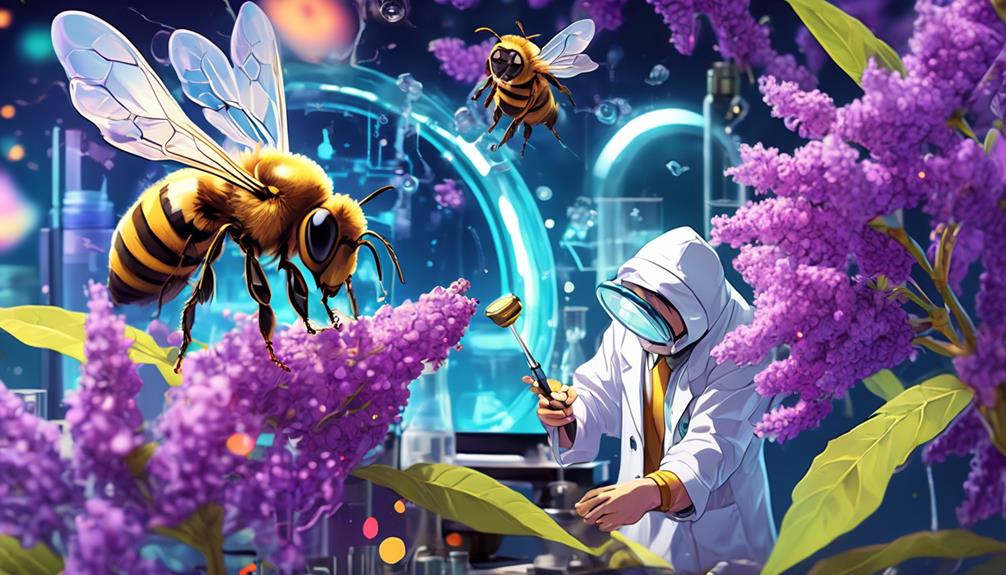
Building on these observations, let's now examine the scientific research that further elucidates the relationship between bees and buddleia.
Over the past few decades, multiple studies have been conducted to understand this interaction.
In a study by Goulson et al. (2017), they found that bees are primarily attracted to buddleia due to its high nectar production. Buddleia, also known as butterfly bush, produces an abundance of sweet nectar throughout the summer. This serves as a readily available food source for bees when other plants may not be flowering.
Another important factor that researchers discovered is the color and scent of the buddleia flowers. Bees are known to have a strong preference for violet and blue flowers, and buddleia's purple blossoms fit the bill. In addition to this, the strong, sweet scent of buddleia flowers helps attract bees from a distance.
Furthermore, buddleia's flower structure also plays a role. The flowers are tubular and grouped in spikes, providing an ideal landing platform for bees. This allows for easier and more efficient nectar collection.
Encouraging Bees: Planting Buddleia
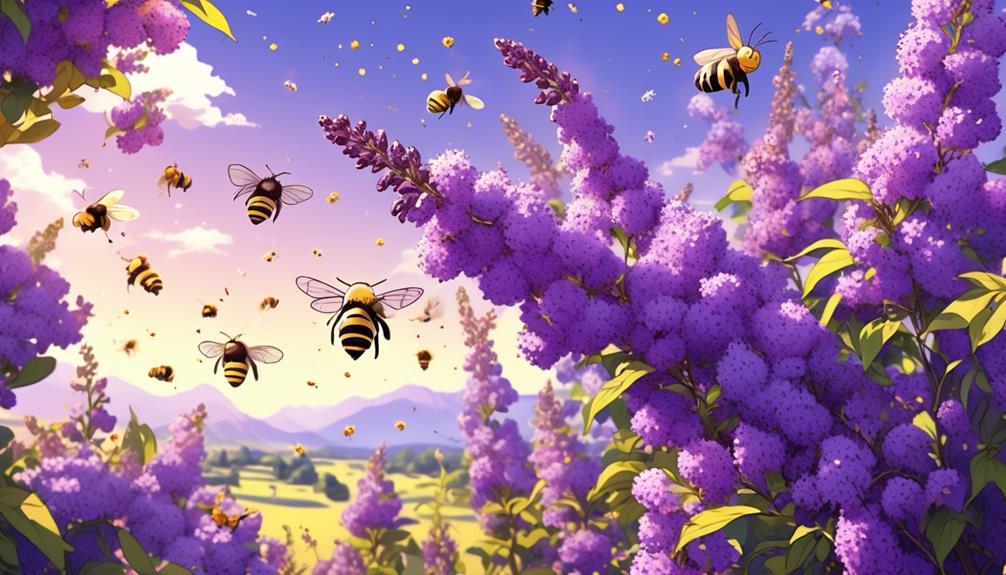
To bolster the bee population in your local area, you could consider planting buddleia in your garden due to its proven appeal to these essential pollinators. Buddleia, also known as butterfly bush, exudes a sweet fragrance that bees can't resist. It's a hardy plant that thrives in full sunlight and well-drained soil, making it an ideal choice for most gardens.
Now, let's delve into the science of why bees are attracted to buddleia. The plant's rich nectar supply is a powerful magnet for bees. The nectar, laden with sugars, provides bees with the energy they need to forage and return to their hives. Moreover, the brightly colored, cone-shaped flower clusters of buddleia are visually attractive to bees. They see in the ultraviolet spectrum and are drawn to the strong contrast between the dark center and bright petals of the flowers.
When you plant buddleia, you're not just beautifying your garden, you're also creating a vital food source for local bees. This simple act can help to stabilize and even increase the bee population in your area, contributing significantly to biodiversity and ecosystem health.
Frequently Asked Questions
What Other Plants Are Known to Attract Bees?
You're curious about what plants attract bees, aren't you?
Well, besides buddleia, there are many others. Lavender's a big hit, its fragrant purple flowers are like bee magnets.
Sunflowers, with their large, nectar-rich centers, also draw them in.
You'll find bees buzzing around marigolds and clovers too.
Herbs like rosemary and thyme aren't just for your kitchen, bees love them too.
Are There Any Particular Species of Bees That Are More Attracted to Buddleia?
Yes, certain species of bees are particularly drawn to buddleia. Honeybees and bumblebees can't resist the sweet nectar of this plant. They're attracted to its bright colors and abundant nectar supply.
Butterflies also find buddleia irresistible. So, if you're looking to attract these beneficial insects to your garden, planting buddleia is a smart move.
But remember, it's important to plant a variety of flowers to attract a diverse range of pollinators.
How Can I Protect My Buddleia Plant From Pests and Diseases?
You'll want to regularly check your buddleia for signs of pests and diseases. If you spot any, remove affected leaves promptly.
It's best to use organic pesticides, as they're less harmful to bees.
Watering should be done at the plant's base to prevent fungal diseases.
Also, proper pruning promotes good air circulation, reducing disease risk. Remember to sterilize your pruning tools to avoid spreading disease.
Lastly, ensure your buddleia gets enough sunlight, as this discourages pests.
What Are the Potential Negative Impacts of Bees Not Being Attracted to Buddleia?
If bees aren't attracted to your plant, it won't get pollinated. This could lead to a decrease in the plant's productivity and overall health. Ultimately, the plant could fail to reproduce, disrupting the local ecosystem.
Additionally, bees play a crucial role in our food supply, so a lack of attraction to certain plants could potentially impact food production.
It's imperative to choose plants that support bee populations.
Can Buddleia Be Grown in Different Climates or Is It Sensitive to Certain Weather Conditions?
Yes, you can grow buddleia in various climates. It's a highly adaptable plant, thriving in both warm and cool conditions.
However, it's sensitive to extreme cold and may not survive harsh winters without adequate protection. Buddleia prefers full sun and well-drained soil. It doesn't do well in waterlogged conditions.
Conclusion
In conclusion, you'll find bees particularly drawn to Buddleia due to its vibrant colors and sweet nectar. Observations and research affirm this attraction, highlighting the plant's role in supporting bee populations.
So, if you're looking to boost your garden's bee activity, planting Buddleia is a scientifically-backed choice. Remember, by doing this, you're not only enhancing your garden's beauty but also contributing to local biodiversity.

